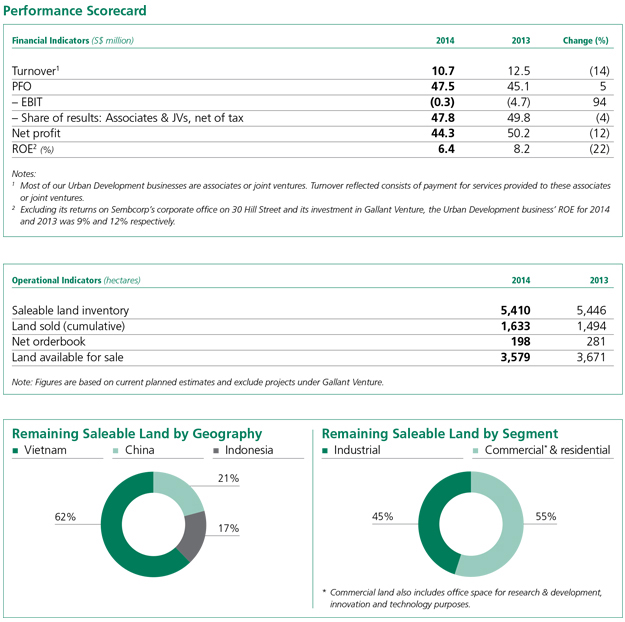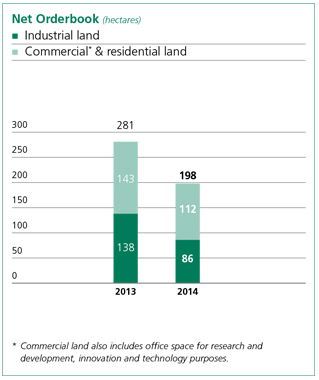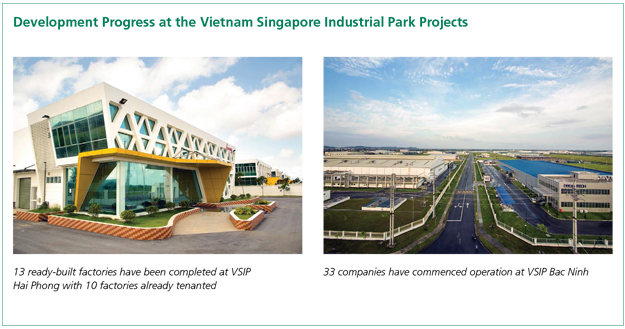Competitive Edge
|
•
|
Over 20 years’ track record in undertaking master planning, land preparation and
infrastructure development to transform raw land into urban developments
|
|
•
|
Significant land bank of integrated urban developments comprising industrial parks
as well as business, commercial and residential space in Vietnam, China and Indonesia
|
|
•
|
A valued partner to governments, with the ability to deliver the economic engine to
support industrialisation and urbanisation by attracting local and international investments
|


OPERATIONS & FINANCIAL REVIEW
Creditable performance amid a challenging year
Against the backdrop of difficult market conditions,
our Urban Development business recorded a net
profit of S$44.3 million compared to S$50.2 million
the previous year. Profit from operations (PFO)
stood at S$47.5 million compared to S$45.1 million
in 2013.
2014 saw a slower property market in China
and dampened investor sentiment in Vietnam
following an unrest in the country. With investor
confidence returning in the fourth quarter, the
business ended the year with a total of 140 hectares
of land sales in Vietnam and China. It also received
commitments from customers for a further
56 hectares of land, bringing its net orderbook
to a total of 198 hectares as at end 2014. Industrial
land accounted for 78% of the land sold in 2014,
while commercial and residential land accounted
for the remaining 22%.
 Vietnam
Vietnam
2014 was a challenging year for our Vietnam
operations. In May, unprecedented riots broke out
across several provinces in the country. Binh Duong
province, where our Vietnam Singapore Industrial
Park (VSIP) I and II are located, was amongst the
worst hit. In the aftermath of the unrest, we saw
cancellations and delays for land orders across all
VSIP projects, with dampened sentiment continuing
through the second and third quarters of the year.
Notwithstanding this, our Vietnam business
delivered a creditable performance for the year.
With investor confidence recovering late in the
fourth quarter, we ended 2014 with higher land
sales than in 2013. In terms of product mix,
industrial land continued to form the bulk of land
sold in the VSIPs, accounting for 94%, while the
remaining 6% of land sold comprised higher-margin
land for commercial and residential purposes.
During the year, we incorporated Sembcorp
Infra Services to provide on-site warehousing and
logistics operations to customers within the VSIP.
This new subsidiary will offer tenants multiple
pick-up and delivery points across the VSIP
projects. It will also offer 15,000 square metres of
warehouse space in VSIP Hai Phong by end 2015.
Response so far has been encouraging, with a
number of customers already making reservations
to take up warehouse space. This new unit widens
our suite of value-added solutions for tenants of
the VSIPs, and is expected to contribute recurring
income to
the business.
 China
China
In 2014, China’s economy posted its weakest
growth in 24 years. This translated to a sluggish
market for land sales. Furthermore, the country
saw a slowdown in industrial growth, with the
Purchasing Managers’ Index decreasing to
50.1 in December 2014 compared to 51.0
in December 2013.
In particular, the performance of our Wuxi-Singapore Industrial Park (WSIP) project, which relies
on factory rental and electricity distribution as its
main sources of income, was affected by poor
sentiment in both the property and manufacturing
sectors. Despite this, the development saw the entry
of a new long-term tenant during the year. It
handed over an 11,000-square metre factory built
to specifications for Muehlbauer, which began an
eight-year lease in June. Take-up for commercial and
residential projects launched by WSIP was marginally
higher compared to 2013. These projects included
WSIP’s business and technology park, which saw 65%
of its initial phase taken up; the International Garden
City residential project, where 171 or 97% of the
apartment units have been sold; as well as Hongshan
Mansion, a new residential development which has
also sold 21 units or 19% of its initial phase.
Meanwhile, our Sino-Singapore Nanjing Eco
Hi-tech Island (SNEI) project saw a slowdown in
new land sales for much of the year. However, this
was mitigated by several announcements from the
local and central governments from the third
quarter of the year. In September, Nanjing’s
municipal government announced the abolition
of restrictions that limit the number of homes
that residents can own, while in October, the
central government eased monetary policy by
lowering its benchmark lending rates. The impact
of these announcements was immediately seen
in an improved take-up of residential units in
Jiangxinzhou, where SNEI is located, as well as
in good response to a public auction of land in
the SNEI in December, with land sales to be
booked next year.
In 2014, our Singapore-Sichuan Hi-tech
Innovation Park made maiden profits from a land
sale. The 1,000-hectare innovation park, located in
the central business district of Chengdu’s Tianfu
New City and within a newly established national-level
economic zone, broke ground in 2012.
 Indonesia
Indonesia
In Indonesia, our new Kendal Industrial Park (KIP)
project in Central Java has already begun to draw
interest from both local and foreign manufacturers.
Two companies have signed expressions of
interest to buy land, even before the formal
launch of the project.
Located along the Jakarta-Semarang-Surabaya
Economic Corridor in Central Java, KIP is positioned
to benefit from the spillover of manufacturing
activity from greater Jakarta. During the year,
the detailed engineering design for the entire
860-hectare project was completed. The first of
KIP’s eight ready-built factories was also constructed,
with the remaining seven to be built on demand.
Land and infrastructure development for the project
continues to progress in preparation for handover
of prepared land to customers in 2015.
Following the dilution of Sembcorp’s stake in
Gallant Venture (GV) to 11.96% and the
reclassification of GV as an available-for-sale
financial asset, our subsidiary Sembcorp Parks
Management has ceased to provide marketing
services to Batamindo Industrial Park and
Bintan Industrial Estate.
OUTLOOK
The Urban Development business has an orderbook
of 198 hectares of land, which will be converted
into sales in the next two years. This comprises 86
hectares of industrial land and 112 hectares of
commercial and residential land. In addition, we
continue to receive enquiries for land within our
projects in Vietnam, China and Indonesia.
While the World Bank has projected global
growth to rise moderately to 3% in 2015, risk
factors for our business include residual uncertainty
as to the outcome of government measures to
promote sustained recovery in the Vietnam and
China property markets. Other risk factors include
economic uncertainty in the eurozone, which may
affect our customers’ export markets, and the weak
yen drawing Japanese investment and manufacturing
activities back to their home base.
Going forward, the outlook for our key markets
is expected to improve. In 2014, Vietnam recorded
gross domestic product growth of just under 6%,
marking its highest growth in three years. Investor
confidence appears to have recovered since the last
quarter of 2014 and in November, Vietnam’s
parliament approved new regulations for the real
estate sector permitting foreign ownership of
property. This is expected to boost interest in
residential real estate. Furthermore, the country is
looking forward to the conclusion of the Trans-Pacific Partnership, which is expected to benefit
Vietnam and its industries, such as the garment
and footwear manufacturing sectors.
While China’s growth has moderated, the
impact on its real estate sector is expected to be
mitigated by new measures introduced by the
authorities, including a rate cut by the People’s
Bank of China in November. Furthermore in the
third quarter of 2014, the government lifted
restrictions in Chengdu, Wuxi and Nanjing on
the number of homes that residents can own.
This is expected to provide a boost to the property
market over the next year.
Meanwhile in Indonesia, pre-launch interest
in KIP has been very encouraging. With the
development’s strategic location in Central Java,
it is well-positioned to capture the spillover of
manufacturing activities from Jakarta. The
project has secured commitments for land,
and continues to receive enquiries from Jakarta-based
manufacturers.
In 2015, the business is expected to deliver
a steady operating performance. As we continue
to focus on the successful execution of our new
projects, we believe we are ready to respond
quickly to a growth momentum in orderbook
and deliver land to our customers.

 SEMBCORP INDUSTRIES ANNUAL REPORT 2014 Operating & Financial Review > Urban Development Review
SEMBCORP INDUSTRIES ANNUAL REPORT 2014 Operating & Financial Review > Urban Development Review Competitive Edge
Competitive Edge



